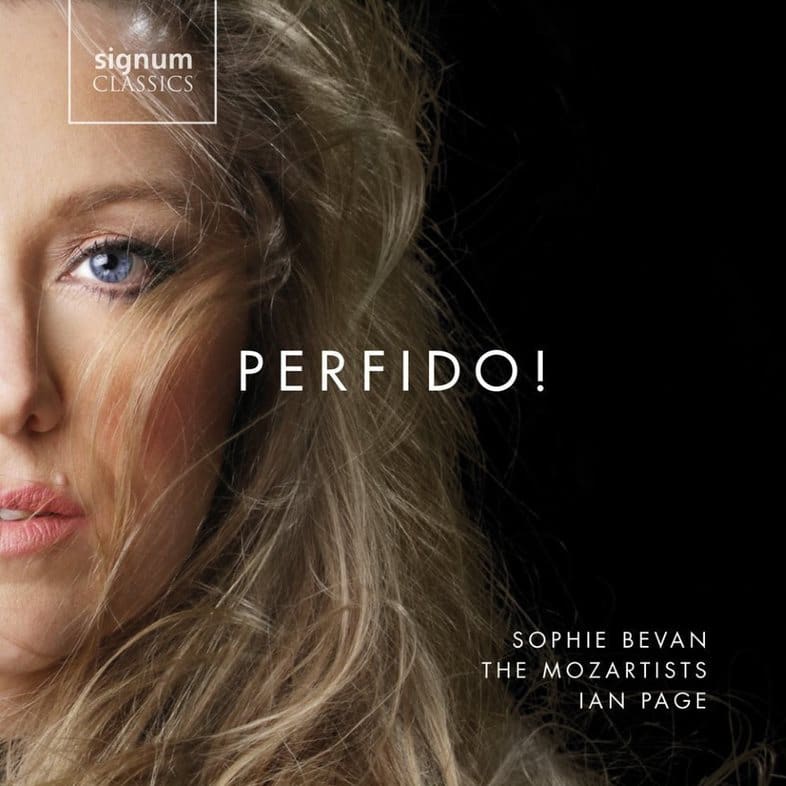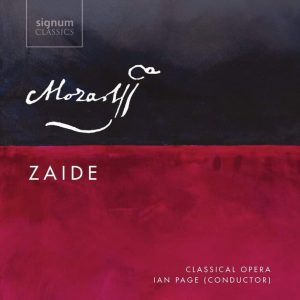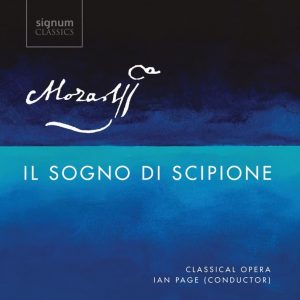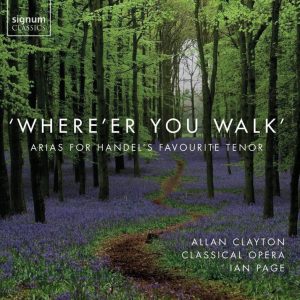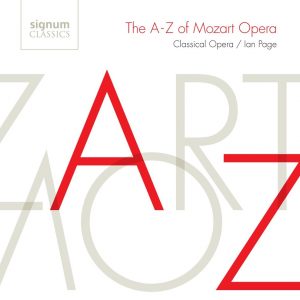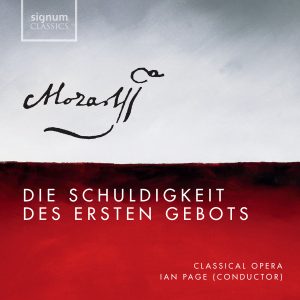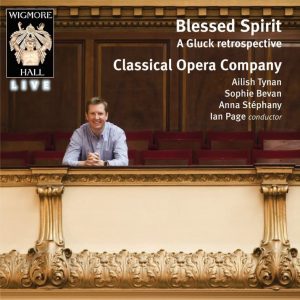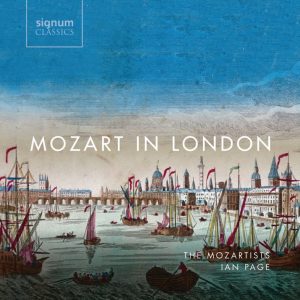“Every ribbon of eloquence that Mozart threaded into the music is unfurled by Bevan with the utmost delicacy.”
JOSEPH NEWSOME, VOIX DES ARTS
‘Perfido!’ was recorded in February 2016 at St Augustine’s Church, Kilburn, and is the first recording by The Mozartists. Ian Page and his orchestra are joined by leading British soprano Sophie Bevan to perform a sumptuous programme of concert arias by Mozart, Haydn and Beethoven.
Sophie Bevan became a Classical Opera Associate Artist in 2007. The recipient of the Young Singer award at the inaugural 2013 International Opera Awards, Sophie Bevan is now at the forefront of the new generation of young British singers.
To order your copy, please click the ‘Buy Now’ button or download a digital version from one of the sites below:
CD 1
- HAYDN: Recitativo, “Berenice, che fai?” *2:14
- HAYDN: Recitativo, “Berenice, che fai?” 2:14
- HAYDN: Aria, “Non partir, bell’idol mio” 2:22
- HAYDN: Recitativo, “Me infelice! Che fingo?” 0:28
- HAYDN: Aria, “Perché, se tanti siete” 5:15
- MOZART: Recitativo, “Oh, temerario Arbace!” 1:15
- MOZART: Aria, “Per quel paterno amplesso” 4:45
- BEETHOVEN: Recitativo, “No, non turbati, o Nice” 1:57
- BEETHOVEN: Aria, “Ma tu tremi, o mio tesoro?” 3:08
- MOZART: Recitativo, “Basta, vincesti, eccoti il foglio” 0:52
- MOZART: Aria, “Ah, non lasciarmi, no” 5:07
- HAYDN: “Solo e pensoso” 6:41
- MOZART: Recitativo, “Ah, lo previdi!” 1:04
- MOZART: Aria, “Ah, t’invola agli occhi miei” 3:12
- MOZART: Recitativo, “Misera! Invan m’adiro” 2:56
- MOZART: Cavatina, “Deh, non varcar quell’onda” 4:50
- MOZART: Recitativo, “Bella mia fiamma, addio” 2:39
- MOZART: Aria, “Resta, o cara” 6:36
- BEETHOVEN: Recitativo, “Ah! perfido” 3:09
- BEETHOVEN: Aria, “Per pietà , non dirmi addio” 5:05
- BEETHOVEN: Allegro assai, “Ah crudel! tu vuoi ch’io mora!” 4:08
Haydn: Scena di Berenice
Franz Joseph Haydn (1732-1809) composed the Scena di Berenice during the second of his two visits to London, and it was first performed as part of his final benefit concert in England.This took place on Monday 4 May 1795 in the New Room of the King’s Theatre, Haymarket, and the programme also featured Haydn’s recently composed ‘Military’ and ‘London’ Symphonies (Nos.100 and 104) as well as concertos by Viotti and Ferlandis and songs by Paisiello and Rovedino. The text represents a dramatic evocation of a loving woman abandoned by her partner, and the work was written for the celebrated dramatic soprano Brigida Giorgi Banti, who had come to London the previous year.
Banti was born near Cremona at some point in the mid to late 1750s, the daughter of a street singer and mandolin player. She made her debut at the Paris Opéra in 1776, singing between the acts of Gluck’s Iphigénie en Aulide, and in her early twenties she moved to London. There she met the dancer Zaccaria Banti, whom she married in Amsterdam in 1779. During the 1780s she enjoyed great success in Venice and Naples, and she also sang in Vienna, Turin, Milan, Warsaw and Madrid. In June 1792 she took part in the inauguration of the Teatro La Fenice in Venice, and from 1794 to 1802 she was engaged as the leading soprano at the King’s Theatre in London.
The musical reminiscences of the splendidly named Lord Mount-Edgcumbe, who himself composed an opera in which Banti sang the title role, recalled how “the most exquisite taste enabled her to sing with more effect, more expression, and more apparent knowledge of her art, than many much better professors; her voice had not a fault in any part of its unusually extensive compass”, while onthe only surviving copy of the hand-bill for Haydn’s benefit concert, an anonymous commentatorwrote: “Banti has a clear, sweet, equable voice, her low & high notes equally good, her recitative admirably expressive.”
To judge from the range and demands of the music Haydn wrote for her in the Scena di Berenice, Banti must indeed have been a most accomplished artist, and yet she seems to have had an off-night at the 4 May concert, for the composer wrote in his diary that “she sang very scanty”. Nevertheless, Haydn was delighted with the overall success of the concert: “The hall was filled with a distinguished audience. The whole society was extremely pleased, and so was I. I netted four thousand florins on this evening. This one can make only in England.” Three months later, after much procrastinating, Haydn reluctantly left London to return to Vienna.
The text is taken from Act 3, scene 9 of Metastasio’s Antigono, a libretto which had originally been set by Hasse in 1743 and subsequently by over thirty composers, including Jommelli (1746), Gluck (1756)*, Traetta (1764) and Paisiello (1785). Although betrothed to Antigono, Berenice is actually in love with his son, Demetrio. Torn between his feelings for Berenice and his filial duty, Demetriocan see no way out of his predicament, and has resolved to kill himself. In “Berenice, che fai?” the disconsolate heroine deliriously laments her fate and longs to die alongside her beloved.
Haydn’s setting of the scene ostensibly comprises two recitatives and two arias, but the effect is inpractice far more organic and unified. From the outset the music is full of dramatic contrasts – fromthe string tremolo depicting Berenice’s icy shivers to the serene oboe and bassoon melody as sheimagines the gods’ contentment at her lover’s death – and this recitative leads directly into the first aria, a tranquil yet impassioned largo in E major. A short linking recitative prefaces the final allegro, a fiery and virtuosic number which races headlong to its frenzied conclusion.
Haydn’s autograph manuscript of the Scena di Berenice contains several hand-written changes which were made at some point after 1797, probably for a concert which took place in Vienna’s Augarten on 22 September 1803. The most significant of these changes is that he cut the opening three bars, possibly because he feared that their soft dynamic might lack the impact to attract an outdoor audience’s immediate attention. For this recording we have put these opening bars on a separate track, to enable the listener to choose either version.
Mozart: “Oh, temerario Arbace… Per quel paterno amplesso”, K.79
Thirty years before the composition of Haydn’s Scena di Berenice, the eight-year-old Wolfgang Amadeus Mozart (1756-91) had also come to London, where he was to spend fifteen formative months. It was here that he wrote his first symphonies and the concert aria for tenor, “Va, dal furor portata”, K.21. Equally significantly he was exposed to a wide array of opera in London’s theatres andsalons, and he reportedly took singing lessons with the celebrated castrato Giovanni Manzuoli. On his homeward journey from London to Salzburg, during an extended stay in The Hague in Holland, Mozart composed two concert arias whose texts are taken from Artaserse, an opera whose popular English setting by Thomas Arne would almost certainly have been heard by Mozart during his stay in London; Mozart, however, set Metastasio’s original Italian. “Oh, temerario Arbace” is the second of these arias.
Even at such a tender age Mozart was already astonishingly fluent and accomplished in setting words to music, and Dr Daines Barrington’s fascinating eyewitness report submitted to the Royal Society in London described how the young Wolfgang had performed for him “an Extemporary opera to nonsense words… [with] an overture of three movements, recitative, Graziosa, Bravura and Pathetic Airs together with accompanied Recitatives, all full of good taste and imagination”.
“Oh, temerario Arbace” begins with Mozart’s first surviving accompanied recitative, a style of writing in which he was to become unsurpassed. It is sung by Arbaces, who has been wrongly imprisoned for the murder of Xerxes. This crime has actually been committed by his own father, Artabanes, but Arbaces refuses to betray him and nobly accepts his fate. As was sometimes the case with arias written for concert performance, the singer assumes both roles in the scene so as to preserve dramatic continuity.
Beethoven: “No, non turbati… Ma tu tremi, o mio tesoro?”, WoO 92a
It was with the intention of studying with Mozart that Ludwig van Beethoven (1770-1827) first came to Vienna in April 1787. In the event his visit was soon cut short when he was called to return to his dying mother in Bonn, and there is no absolute proof that the two men ever met; by the time Beethoven returned to Vienna five years later – this time for good – Mozart was dead. Although he had already composed some impressive and distinctive works, including the Cantata on the Death of Emperor Joseph II, Beethoven clearly still felt the need for further study, and he continued to have lessons throughout his first decade in Vienna, voraciously plugging the gaps in his musical education. These lessons focused on two main areas – initially with Haydn and subsequently with Johann Georg Albrechtsberger he studied strict counterpoint, and with the court Kapellmeister Antonio Salieri he studied Italian prosody and vocal composition. All three teachers seem to have had a similar impression of the young firebrand, for several years later Beethoven’s own pupil, Ferdinand Ries, was to recall how “they all said that Beethoven was so headstrong and wilful that he often had to learn through bitter experience what he had refused to accept when it was presented to him during the course of his lessons”.
Lessons with Salieri were probably quite sporadic; in his later years Salieri set aside three mornings a week to give free tuition to talented young composers and singers, and Beethoven continued to take advantage of this generosity at a surprisingly late stage in his development. We know this from the aria “No, non turbati”, which was composed under Salieri’s supervision between 1801 and 1802, by which time Beethoven had already composed many important works, including his first symphony, the first two piano concertos, Die Geschöpfe des Prometheus and indeed the concert aria “Ah! perfido”.The autograph manuscript even contains Salieri’s corrections, although in truth not all of his changes are improvements (for this recording we have in several instances retained Beethoven’s original). The work is scored for soprano and strings, and the text is taken from Metastasio’s La tempesta. In the opening accompanied recitative Beethoven seizes the various opportunities to evoke in his orchestral writing the thunderstorm that is brewing, and this is carried through into the aria, marked ‘andante agitato’, in which the poet, having persuaded his beloved Nice to take shelter with him in a nearby cave, seeks to pursue his amorous ambitions.
Mozart: “Basta, vincesti… Ah, non lasciarmi, no”, K.486a/295a
This aria was written in Mannheim in February 1778, and is the only concert aria that Mozart wrote for the German soprano Dorothea Wendling (1736-1811); two-and-a-half years later she was to create the role of Ilia in Idomeneo. She was the daughter of a Stuttgart horn-player and his lutenist wife, and was married to the principal flautist in the Mannheim orchestra, Johann Baptist Wendling, whose playing was greatly admired by the Mozarts. She had been appointed a court singer at Mannheim in 1752, and by the time Mozart met her she had enjoyed two decades as the undisputed leading soprano there, performing major roles in operas by Jommelli, Holzbauer, Piccinni and J. C. Bach. The poet and novelist Christoph Martin Wieland wrote in 1777: “Her manner of singing surpasses anything I have ever heard… This alone is true singing – the language of the soul and the heart.”
The text of “Basta vincesti” is taken from Act 2, scene 4 of Metastasio’s Didone abbandonata. Dido, Queen of Carthage, has been rejected by her beloved Aeneas. Seeking to provoke a reaction from him she has signed a document accepting the marriage proposal of Jarba, King of the Moors, and the jealous Aeneas has duly demanded that she retract this acceptance. As she succumbs to her true feelings and hands the document over for Aeneas to destroy, she begs him to remain faithful and not to abandon her. Her anguished anxiety, insecurity and tenderness are beautifully captured by the plaintive yearning of the melodic line and the burnished orchestral texture, featuring flutes, bassoons and muted violins.
Haydn: “Solo e pensoso” (Petrarch Sonnet No.28)
According to the work’s autograph manuscript it was a Russian ‘Grand Prince’ who suggested to Haydnthat he set Petrarch’s sonnet “Solo e pensoso”. Composed in 1798, this was to be Haydn’s final Italian aria, and it was not actually published until 1961. It was first performed at the two Christmas concerts of the Tonkünstler-Societät in Vienna, on 22 and 23 December 1798, with a certain Antonie Flamm as soloist. She seems to have been a contralto, in which case she must have been tested by the range of the aria; this perhaps accounts for the subsequent report submitted by the Society on 12 February 1799, which asserts that “Mademoiselle Flamm was found very unsatisfactory by the audience”.
“Solo e pensoso” was one of the many sonnets inspired by Petrarch’s unrequited love for a woman called Laura. It follows the standard Italian sonnet form which Petrarch made famous, consisting of eight lines (comprising two quatrains rhyming A B B A) followed by a contrasting sestet comprising two sets of three lines. This natural division into two parts lends itself well to musical setting, and the beguiling charm of Haydn’s second section, with chirping clarinets and bassoons to the fore, contrasts effectively with the soulful isolation and introspection of the first part. If this opening section evokes the tonal palette and spiritual depth of Haydn’s late masses – indeed the opening melodic figure is almost identical to the opening of the Agnus Dei from the ‘Nelson’ Mass – the second part recalls the bucolic naivety and open-heartedness of The Creation, which had received its first performance earlier in 1798.
Mozart: “Ah, lo previdi… Ah, t’invola agl’occhi miei”, K.272
This was the first of the two great concert arias which Mozart wrote for the celebrated Czech soprano Josefa Dušek. She was two years older than Mozart, having been born in Prague in 1754, and had married the well-known Czech composer and pianist Franz Xaver Dusek (1731-1799) in 1776. In August of the following year the couple met the Mozarts while visiting Josefa’s grandfather in Salzburg, and this meeting resulted in the composition of “Ah, lo previdi”.
The text was taken from a libretto by Vittorio Cigna-Santi (who had previously written the libretto for Mozart’s Mitridate, re di Ponto) for the opera Andromeda. This libretto had already been set by at least four composers – most recently by Giovanni Paisiello in 1774 – and the story of Perseus’ rescue of Andromeda from a sea monster had been one of the most popular subjects throughout early opera; by 1800 over twenty-five independent librettos had been written on the subject. In Cigna-Santi’s version of the story, Andromeda is in love with Perseus but is obliged to marry Euristeo, the successor to the King of Argos. When Euristeo tells Andromeda that he has seen Perseus wandering about dementedly with an unsheathed sword, she supposes that Perseus has killed himself. She turns her fury on Euristeo for not having prevented the imagined suicide, before subsiding into resignation and acceptance as she envisages following her beloved on his journey to Hades. In an exquisite cavatina, she begs Perseus to await her arrival so that they can cross the River Lethe together, a sorrowful oboe solo plaintively interweaving with her expressions of grief and yearning.
This work was clearly close to Mozart’s heart. A year after its composition he sent a copy of the music to Aloysia Weber – with whom he had fallen deeply in love – urging her to study the aria. In his only surviving letter to her, dated 30 July 1778, he offers her impassioned guidance on how to prepare the music, writing: “I advise you to observe the expression marks – to think carefully of the meaning and the impact of the words – to put yourself in all seriousness into Andromeda’s situation and position! – and to imagine that you really are that very person.” This document offers a fascinating insight into the depth and intensity with which Mozart connected to his material, and the work remains one of the composer’s most extraordinary, though curiously little-known, masterpieces.
Mozart: “Bella mia fiamma… Resta, o cara”, K.528
When Mozart came to Prague in 1787 for the premiére of Don Giovanni, he and his wife stayed with the Dušeks at Villa Betramka, their summer residence on the outskirts of the city; Mozart reportedly put the finishing touches to the opera while seated in the garden of the villa. Following the opera’s triumphant premiére on 29 October, the Mozarts remained in Prague for several weeks. Josefa Dušek, however, insisted that Wolfgang was not allowed to leave Betramka until he had composed a new aria for her, and she is said to have locked him in the pavilion in the villa’s garden until he had completed the work. Mozart’s son later recollected how his father “retorted that if she could not sing the song correctly and well at first sight he would not give it to her”, and this story of Mozart’s impish humour is given credence by a remarkably bold and harmonically complex passage in the aria which would have caused problems for even the most accomplished sight-reader. The manuscript of “Bella mia fiamma” is dated 3 November, but the speed with which it was composed belies the work’s depth and mastery. The text is taken from Cerere placata (‘Ceres Appeased’), a ‘festa teatrale’ composed in 1772 by Niccolò Jommelli to words by Michele Sarcone. Titano is the mortal lover of the goddess Proserpina, whose mother Ceres has decreed that the pair must separate and that Titano must die. Titano here laments his fate and consoles his beloved Proserpina as he takes his final leave of her, but any sense of heroic fortitude is imbued with a profound sense of pain and anguish at his plight, a sense heightened by the pathos and chromatic intensity of Mozart’s remarkable music.
Beethoven: “Ah! perfido”, Op.65
Following Mozart’s “Ah, lo previdi” (1777) and “Bella mia fiamma” (1788), the third great concert aria written for Josefa Dušek was composed by the young Beethoven in 1796. Early that year he embarked on a tour to Prague and Berlin (with stops at Dresden and Leipzig) which was intended to last for six weeks but in the event took six months. He composed “Ah! perfido” in Prague, and although it was dedicated to the local patron and music-lover Countess Josephine de Clary it was first performed – in Leipzig on 21 November 1796 – by Josefa Dušek, and it was surely for Dušek, herself a native of Prague, that Beethoven conceived the work.
Beethoven’s compositional studies with Haydn during 1793 may have proved singularly unsuccessful – the demanding student had felt (evidently with some justification) that his teacher was not providing the rigid discipline and attention to detail that he craved, and the composer and teacher Johann Baptist Schenk subsequently claimed that during this period Beethoven had started taking extra lessons with him behind Haydn’s back – but he was still able to learn a great deal from Haydn’s compositions. Haydn had written his Scena di Berenice in London the year before Beethoven wrote “Ah! perfido”, and he had brought the score back with him when he returned to Vienna. “Ah! perfido” is modelled on a very similar structure and harmonic design; like Haydn’s work it is a lengthy and highly charged dramatic monologue delivered by a distraught lover, and the music has an exquisitely poised nobility of utterance. The text for the opening recitative is again by Metastasio, this time from a widely admired soliloquy in Achille in Sciro; the source and authorship of the ensuing text, however, has not been identified, and it was possibly created specifically for Beethoven’s composition. The work was not published until 1805, hence its misleadingly high opus number.
© Ian Page
The Mozartists, Alison Bury (leader), Rachel Chaplin (oboe solo, track 16)

